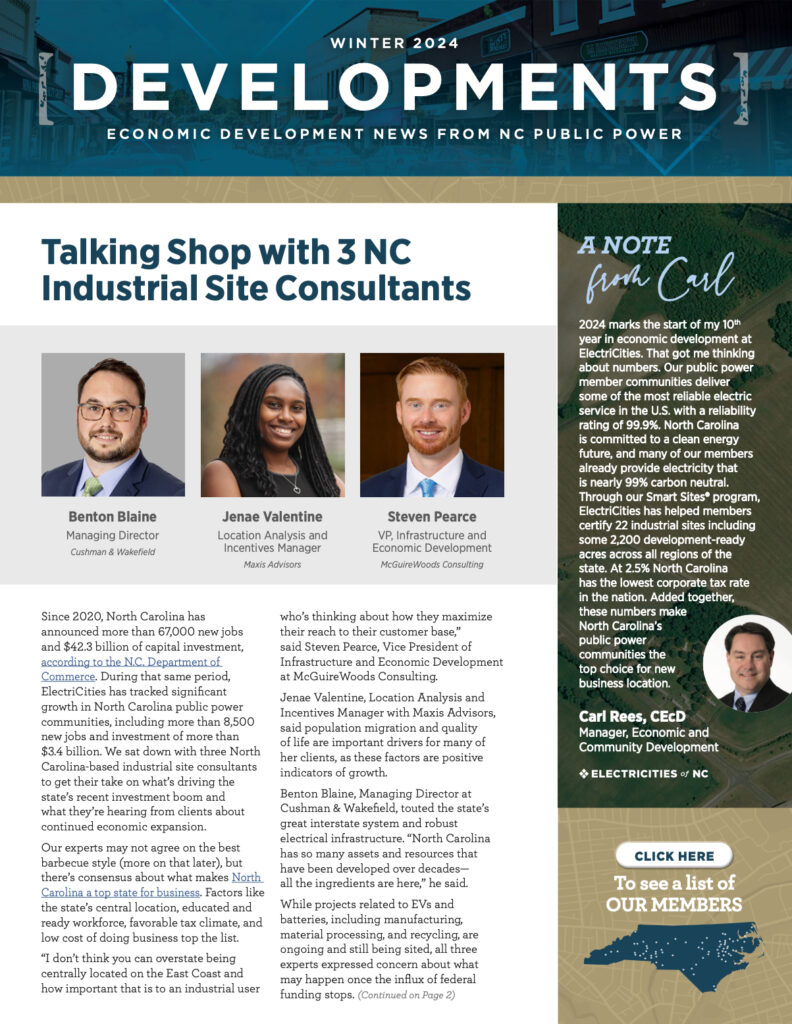Sponsored by
Since 2020, North Carolina has announced more than 67,000 new jobs and $42.3 billion of capital investment, according to the N.C. Department of Commerce. During that same period, ElectriCities has tracked significant growth in North Carolina public power communities, including more than 8,500 new jobs and investment of more than $3.4 billion. We sat down with three North Carolina-based industrial site consultants to get their take on what’s driving the state’s recent investment boom and what they’re hearing from clients about continued economic expansion.
Our experts may not agree on the best barbecue style (more on that later), but there’s consensus about what makes North Carolina a top state for business. Factors like the state’s central location, educated and ready workforce, favorable tax climate, and low cost of doing business top the list.


“I don’t think you can overstate being centrally located on the East Coast and how important that is to an industrial user who’s thinking about how they maximize their reach to their customer base,” said Steven Pearce, Vice President of Infrastructure and Economic Development at McGuireWoods Consulting.
Jenae Valentine, Location Analysis and Incentives Manager with Maxis Advisors, said population migration and quality of life are important drivers for many of her clients, as these factors are positive indicators of growth.
“North Carolina has so many assets and resources that have been developed over decades — all the ingredients are here.”
— Benton Blaine, Managing Director,
Cushman & Wakefield
Benton Blaine, Managing Director at Cushman & Wakefield, touted the state’s great interstate system and robust electrical infrastructure. “North Carolina has so many assets and resources that have been developed over decades—all the ingredients are here,” he said.
While projects related to EVs and batteries, including manufacturing, material processing, and recycling, are ongoing and still being sited, all three experts expressed concern about what may happen once the influx of federal funding stops.


“I don’t have a crystal ball, but I think we’ll see fewer and smaller EV and battery projects when federal dollars aren’t there to support them,” Pearce said.
Blaine said he expects to see a more diversified market, including lower-tier suppliers in EV, as well as manufacturing projects in solar, transformers, food, and life science.
When it comes to electric service, top considerations are reliability and cost, our experts said. Clients also want to know the source of their electricity and how much of the mix is renewable.
Valentine said, “My clients want to understand an electric provider’s ability to meet their ramp-up schedule so that when they’re ready to become fully operational, they’ll have the power needed to support their manufacturing operations.”
Knowing power is available is trickier these days.
“Up until 2019, my largest project was 11 megawatts, and that was a big project. Now I have a 150, a 100, an 80, two 60s, and a 40,” Blaine said. “We’re talking about projects that need to use a measurable portion of an entire power plant.”
Part of the fun of site selection in North Carolina is watching trend lines to forecast continued industrial growth.


Along with watching what he calls the natural progression of the EV supply chain, Blaine hopes we’ll see incentives for workforce training that supports current and future technology.
Pearce is watching the impact of the uncertainty that often comes with election years and current geopolitical movement. Since higher interest rates impact investment, he’s hopeful they’ll drop this year. He’s also watching population growth—or lack of it, based on recent data.
Along with all that, Valentine said she’s keeping an eye on construction costs, industrial lease rates, industrial vacancy, and job reports.
Whatever the future brings, it’s clear that each of these industrial site selection consultants appreciates what our state has to offer and that each enjoys calling North Carolina home.
They do not, however, enjoy the same style of North Carolina barbecue. Blaine and Valentine share an affinity for Lexington-style, while Pearce prefers Eastern-style. When it comes to the ’cue, let’s just agree to disagree.

